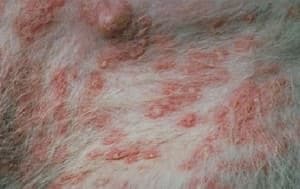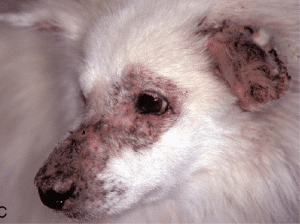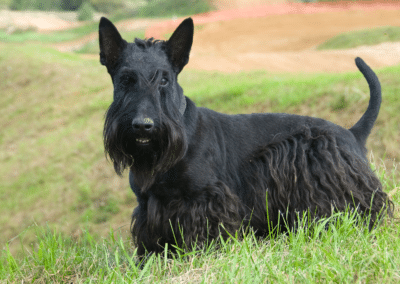Dog skin conditions are widespread, with over 160 different documented conditions. These conditions can be a reaction to a variety of both internal and external issues including flea bites, parasites, bacteria, food or seasonal allergies, and even stress or boredom. When the skin is affected, dogs may respond by scratching, licking, and/or chewing the infected area.
General Symptoms of Dog Skin Conditions
- Scratching, licking, or chewing infected area
- Rubbing their face against furniture or carpeting
- Greasy looking coat
- Foul odor to the skin
- Chronic inflammation of the ear canal
- Rashes, redness, or inflammation
- Hot spots (areas of intense itching)
- Dry, flaky skin (resembling dandruff)
- Scabs or crusty areas on skin
- Bald patches or hair loss
- Swellings, lumps, or skin discoloration
- Anal gland problems
Diagnosis of Dog Skin Conditions
If your dog has several of these symptoms listed above, your veterinarian can conduct a physical exam followed by diagnostic tests such as a skin biopsy, a blood or allergy test, or a microscopic examination of the hair and skin for presence of parasites or infection.
Treatment and Management of Dog Skin Conditions
Treatments will vary greatly depending on the primary cause. While some treatments can be as simple as a diet change or applying topical products, other conditions can require the use of steroid injections or immunosuppressive agents as well as an oral antibiotic, antifungal, or anti-itching medications.
If the condition is an incurable disease, then managing the problem through selected diets, medications, shampoos, sprays, fatty acids, and nutritional supplements can provide long-term relief for your dog. It is important to note that since normal skin cells are replaced approximately every 28 days, you may not see dramatic results for three to four weeks.
Prevention of Dog Skin Conditions
The use of natural, hypoallergenic soaps and shampoos are recommended but do not bathe your dog too often as it can strip their skin of protective oils and good bacteria. Grooming according to the needs of the breed will keep your dog’s skin and coat in a clean and healthy condition.
Regularly vacuuming and dusting your house and washing pet bedding will lower the risk of parasites. Feed your dog a biologically appropriate, grain-free diet without fillers or artificial ingredients and supplement the diet with nutritional products developed specifically for the canine skin and hair coat.
Parasitic Skin Conditions
Flea and mite bites are irritating and can cause allergic responses which can lead to over scratching and hair loss. Ticks are relatively harmless while others carry devastating diseases. See: Canine Tick Problems
Infectious Skin Diseases
Ringworm in Dogs

This is a fungal infection that can result in inflammation, scaly patches, and hair loss usually indicated by a reddened area that develops into a small ring and slowly enlarges. Ringworm is highly contagious so you should find treatment immediately to avoid infecting other pets and people in the household.
Pyoderma in Dogs

Pyoderma is a bacterial skin infection, which results in pimples, lumps, bumps, and areas of redness (this can look similar to a diaper rash for babies).
Chronic Bacterial Dermatitis in Dogs
This bacterial condition is the most common in dogs and requires antibiotic therapy. Symptoms can include circular patches of hair loss and tiny inflamed eruptions that evolve into crusty patches.
Alabama Rot in Dogs
This condition is thought to be caused by E. Coli toxins, which can cause eventual kidney failure if left untreated. Common symptoms are skin lesions or patches of skin that look similar to an ulcer and typically appear on legs or paws but can also be found on a dog’s face.
Malasseza in Dogs
This is a yeast infection that is found on the skin and most commonly the ears of dogs. Symptoms can include loss of hair, redness of the affected area, and malodorous discharge from lesions.
Non-Infectious Dog Skin Problems
Much like humans, dogs can also be affected by seasonal changes and seasonal allergies. Dogs get dry, flaky skin in the winter due to the lack of humidity in the air. Summer conditions in some parts of the country can lead to excessive moisture that can irritate skin folds, and common substances like pollen, weeds, dust, mites, trees, grasses, or mold can cause allergic reactions.
Contact allergies from certain grooming products or cleaning agents can be irritating to your dog’s skin and are also common causes of skin allergies. See: Pet Allergies
The number one cause of skin conditions in dogs is poor-quality food. Dogs can develop allergies to common ingredients in pet foods such as wheat or corn, which can lead to skin irritations, rashes, vomiting, and diarrhea. Poor food quality, particularly food with added artificial ingredients, can lead to several skin conditions such as Seborrheic dermatitis, which is caused by low fatty acid and protein levels in the diet.
Hereditary and Developmental Diseases in Dogs
Conditions such as canine acne, ichthyosis, and atopy are inherited and can range from trivial annoyances to severe skin destruction. Ichthyosis is a recessive genetic mutation that prevents the outer layer of skin from forming properly, resulting in thick, darkened patches of skin that flake excessively. Atopy, also known as allergic inhalant dermatitis, mimics other itchy, destructive skin disorders and is usually shown by increased itchiness around the eyes, muzzle, ears, and feet.
Metabolic or Hormonal Problems in Dogs
Several common hormonal problems can cause changes in skin color, coat consistency, thickness, and distribution. Imbalances such as hypothyroidism, Cushing’s disease, and adrenal gland disorder are often not curable but can be managed once proper therapy is instituted.
Immune-Mediated Disorders in Dogs

Skin disease may result from suppression or overactivity of the immune system. Pemphigus foliaceus is the most common autoimmune disease, which typically causes blisters on the face and ears to rapidly break and form crusts and erosions.
Self-Inflicted Skin Conditions in Dogs
While a dog may excessively lick or chew its skin for many reasons, it likely occurs when a dog is not provided adequate exercise or mental stimulation. Licking or chewing due to stress or boredom can result in physical skin lesions that are difficult to cure.
Hot Spots on Dogs

Acute Moist Dermatitis, more commonly referred to as ‘Hot Spots’ is an acutely inflamed area of the skin that is worsened by a dog constantly licking or chewing its skin.
Acral Lick Granulomas on Dogs

Acral lick granulomas are characterized by a raised, usually ulcerated area on a dog’s foot or leg, caused by incessant, compulsive licking.
This material is provided for educational purposes only and is not intended to diagnose or treat any disease or condition. All specific treatment decisions must be made by you and your local, attending veterinarian.








0 Comments